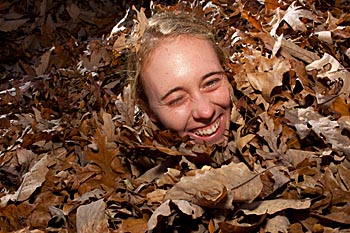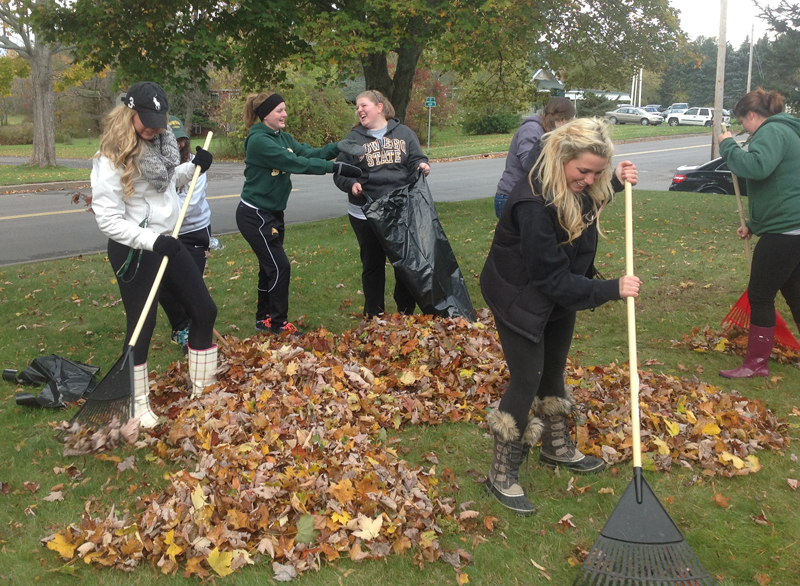Leave Those Leaves!
By Marsha Goldberg, Fairfax Master Gardener
 My friend David dislikes fall garden chores so much that his license plate reads, “IH8RAKING.” My coworker Tom’s back aches so intensely after weekends spent ridding his lawn of leaves that he can barely move from his desk chair on Mondays. And I’m always amused when I see my neighbors put out piles of leaf-filled bags one autumn week and then order truckloads of mulch the next.
My friend David dislikes fall garden chores so much that his license plate reads, “IH8RAKING.” My coworker Tom’s back aches so intensely after weekends spent ridding his lawn of leaves that he can barely move from his desk chair on Mondays. And I’m always amused when I see my neighbors put out piles of leaf-filled bags one autumn week and then order truckloads of mulch the next.
David, Tom and the gardeners in my ‘hood could save themselves much money and labor by learning to love — and use — their fallen foliage. Leaves are one of the best soil amendments Mother Nature provides, and she gives them to us for free.
Trees pull nutrients from soil and air all summer, storing them in their leaves. When the leaves drop, they are ready to return those nutrients to the soil. Instead of raking, bagging and disposing of leaves, you can run over them with a mulching mower and let the chopped bits decompose where they lie. Doing so will supply your lawn with a constant source of rich nutrients.
You can also collect the chopped leaves in your mower’s bag and use them in several ways to enrich your garden. As a mulch, they will keep weeds at bay in your beds and then break down to improve the soil. You can also add chopped leaves to your compost pile. You may have learned the hard way that using only kitchen scraps in your compost produces a stinky mess — the result of too much nitrogen. To avoid that problem, store some of the chopped leaves in plastic bags near your compost bin. Each time you add kitchen scraps, throw in a handful or two of leaves. Their carbon will balance the mixture, preventing the problem odor. Leaves will also increase the biomass of your bin and attract worms, which speed up the decomposition process.
If you overwinter plants in pots, they will fare better if cozily nested in leaves. Position your pots close together, encircle them with a bin made of wire, and cover them with leaves. Remove the leaves as soon as the weather warms in early spring.
I plant my vegetables in raised beds, so each fall I spread the beds with my chopped leaves. Come spring, I pull back a small amount of leaves, dig my planting hole, and then put the leaves back around the stem of the new plant. The leaves serve to reduce weeds and, as they decompose, provide nutrients to the plant.
Chopped leaves are also great for sheet composting, or lasagna gardening, a method for starting a new bed without digging. In fall, put down a layer of cardboard or multiple sheets of newspaper, pile shredded leaves on top, and then add other organic materials such as manure, compost, straw, or grass clippings. The materials will decompose enough by spring for you to plant in the bed.
 Last year, controversy erupted in the gardening world when the National Wildlife Association recommended leaving whole leaves on the ground to provide shelter for insects and other small animals. Many garden writers quickly responded, saying that allowing the leaves to remain whole is the worst thing you can do for your lawn. The leaves mat down, they said, keeping water from grass or plants. They also harbor potentially harmful wildlife and because they stay moist in winter, the leaves encourage fungus to grow. There is truth to all that, but think about natural spaces such as forests and woodlands where leaves remain where they fall; or think of large arboretums where it would be impossible to process all the leaves. They are left to decompose naturally.
Last year, controversy erupted in the gardening world when the National Wildlife Association recommended leaving whole leaves on the ground to provide shelter for insects and other small animals. Many garden writers quickly responded, saying that allowing the leaves to remain whole is the worst thing you can do for your lawn. The leaves mat down, they said, keeping water from grass or plants. They also harbor potentially harmful wildlife and because they stay moist in winter, the leaves encourage fungus to grow. There is truth to all that, but think about natural spaces such as forests and woodlands where leaves remain where they fall; or think of large arboretums where it would be impossible to process all the leaves. They are left to decompose naturally.
The best way to respond to the various arguments is to determine how you use your spaces and how you want them to look. Leaves left whole will mat down, block moisture, and eventually ruin the grass. If, however, you chop your leaves and leave the bits on the ground, your lawn will look dry and brown but only for a few days. As the leaves decompose and turn black, your lawn will look more attractive. If you want to use them in a compost pile or as a mulch on an ornamental or vegetable bed, whole leaves will eventually decompose, but the process will be faster if you chop the leaves first. In large wooded areas where the understory will not be affected, whole leaves will provide some benefit to the wildlife.
There are many methods to chop leaves. A mulching mower, one of the best tools for the task, chops leaves and sends them back into the collection bag, but you also have the option of leaving the chopped debris on the lawn. If you want to speed decomposition, make the bits smaller by running the mower over them a second time. Lawn vacuums also chop leaves as they collect them. Many leaf blowers have a setting that lets you reverse the blower so it picks up and chops leaves as they go into the collection bag. Leaf shredders are yet another option. The least costly of these fits on top of a trashcan, but you can achieve the same result even less expensively by piling leaves in a large trash bin and chopping them with a weed whacker. This method, however, is much slower and somewhat messy; if you try it, be sure to wear goggles.
I have to admit that I actually love fall cleanup. I enjoy being out in the cool air, listening to my favorite gardening podcast, and getting into “the zone.” But I have the right tools for the task, turning a potentially boring and physically demanding chore into a calming and gratifying activity. If you are still struggling each fall to clean up and dispose of leaves, please consider the alternative: Learn to love those leaves and make them work for you instead!